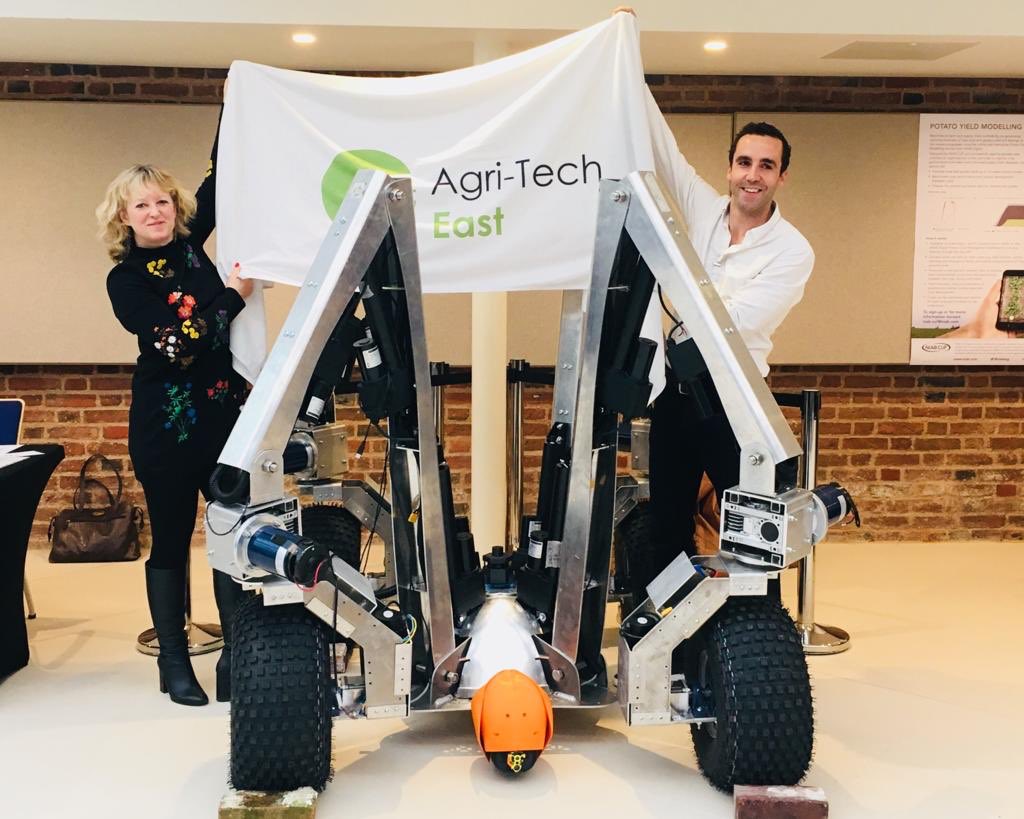
Small Robot Company, the British agritech start up for sustainable farming, announced the official unveiling of its Harry digital planting robot at Agri-Tech East’s REAP 2018 Conference in Cambridge.
Just one year on since Small Robot Company first previewed its ‘Farming as a Service’ model at REAP 2017, the Small Robot Company is unveiling Harry, as well as showing an early version of its Wilma Artificial Intelligence interface.
Harry is a prototype of the world’s first digital drilling robot for combinable crops, one of three precision engineered, smart robots. Small Robot Company’s Tom, Dick and Harry robots will feed, seed and weed arable crops autonomously, with no waste. This could revolutionise food production and the toll big machinery takes on soil and the wider environment.
Harry, a 1.8 metre-square spider-shaped robot, compactly folds and unfurls to provide farmers with a driverless, super accurate drill that punch-plants seeds at a uniform depth, making minimal soil disturbance. He is able to accurately record exactly where he has placed individual seeds, and feeds this data back to the Small Robot Company’s artificial intelligence platform, called Wilma, to produce a per-plant crop map.
An early version of the interface for Wilma is also on show at REAP 2018. Other robots, Tom and Dick, are already in trial and due for development next year, respectively. Directed by Wilma, the farmbots will only feed and spray the plants that need it, giving them the perfect levels of nutrients and support – cutting chemicals and emissions by up to 95%.
In recent years farming costs have increased by 10-12% per year, particularly with regards to machinery, putting much more strain on farmers. Fourth-generation farmer Sam Watson Jones and entrepreneur Ben Scott-Robinson wanted to offer farmers an innovative solution. Inspired by the work of Professor Simon Blackmore, at the National Centre for Precision Farming at Harper Adams University, Sam and Ben came up with the idea for Tom, Dick and Harry.
Sam explains: “Before we even started working on the technology, we looked at the pain points farmers were facing and realised the old model had to change. Our AI-driven operating system will give farmers a more detailed knowledge of their crop and their land, allowing them to be more efficient and environmentally friendly. This will entirely change what’s possible on the farm, and how we think about farming.”
Trials are currently taking place on the National Trust’s Wimpole Estate. The National Trust’s Food and Farming Researcher, Felicity Roos, commented:
“Big tractors are effective but environmentally damaging and inefficient – currently, 95% of energy is used ploughing and this is only necessary because the use of heavy machinery compacts the soil.
“Small Robot Company are building robots that will seed and care for each individual plant in a crop. For farmers the increased efficiency has the potential to increase yields, and reduce input costs and so hopefully increase profits.”
The Harry prototype has been developed thanks to a prestigious Horizontal Innovation Award from the Institution of Engineering and Technology (IET) and the High Value Manufacturing Catapult (HVMC), which the Small Robot Company to harness the power of manufacturing technologies used in pharmaceuticals and construction to deliver Harry’s precision drilling and planting mechanism.
“Feeding an estimated extra 2.2 billion people living on planet earth by 2050 is going to be one of the biggest challenges we face in the future,” says Alan Howard, the IET’s Design and Manufacturing Lead.
“This brilliant idea from Small Robot Company, with its ingenious application of robotics and automation technologies, could provide a vital and secure source of food to help feed the world”.
“Exactly a year ago we launched our agritech robotics concept at REAP 2017. And now today, we have three prototype robots and an early version of our artificial intelligence, with field trials underway at twenty farms including the National Trust,” concludes Sam.
“We’ve already come such a long way. We’re hugely thankful for the early support from Agritech East and the Institute of Engineering and Technology, without which we wouldn’t have got so far so fast.”




